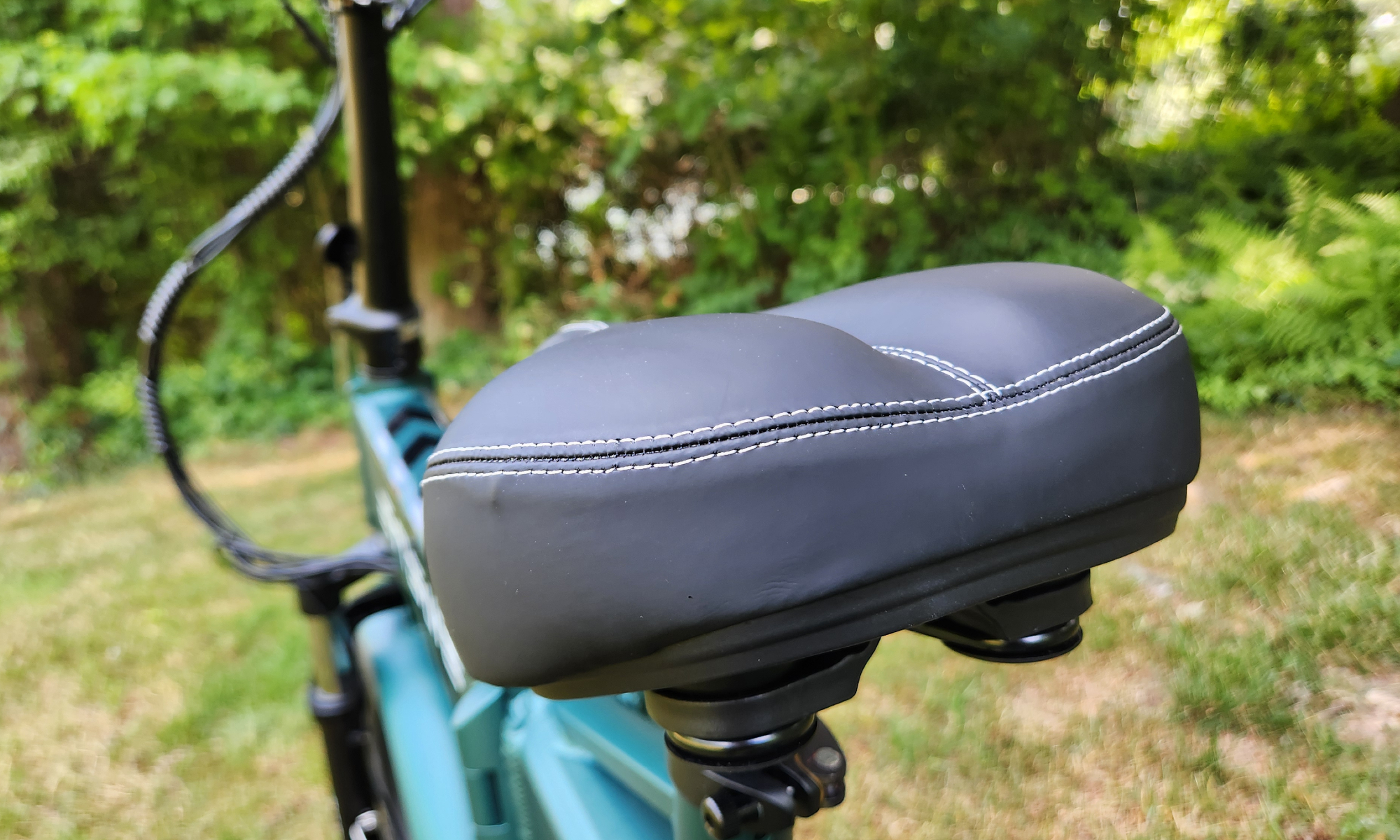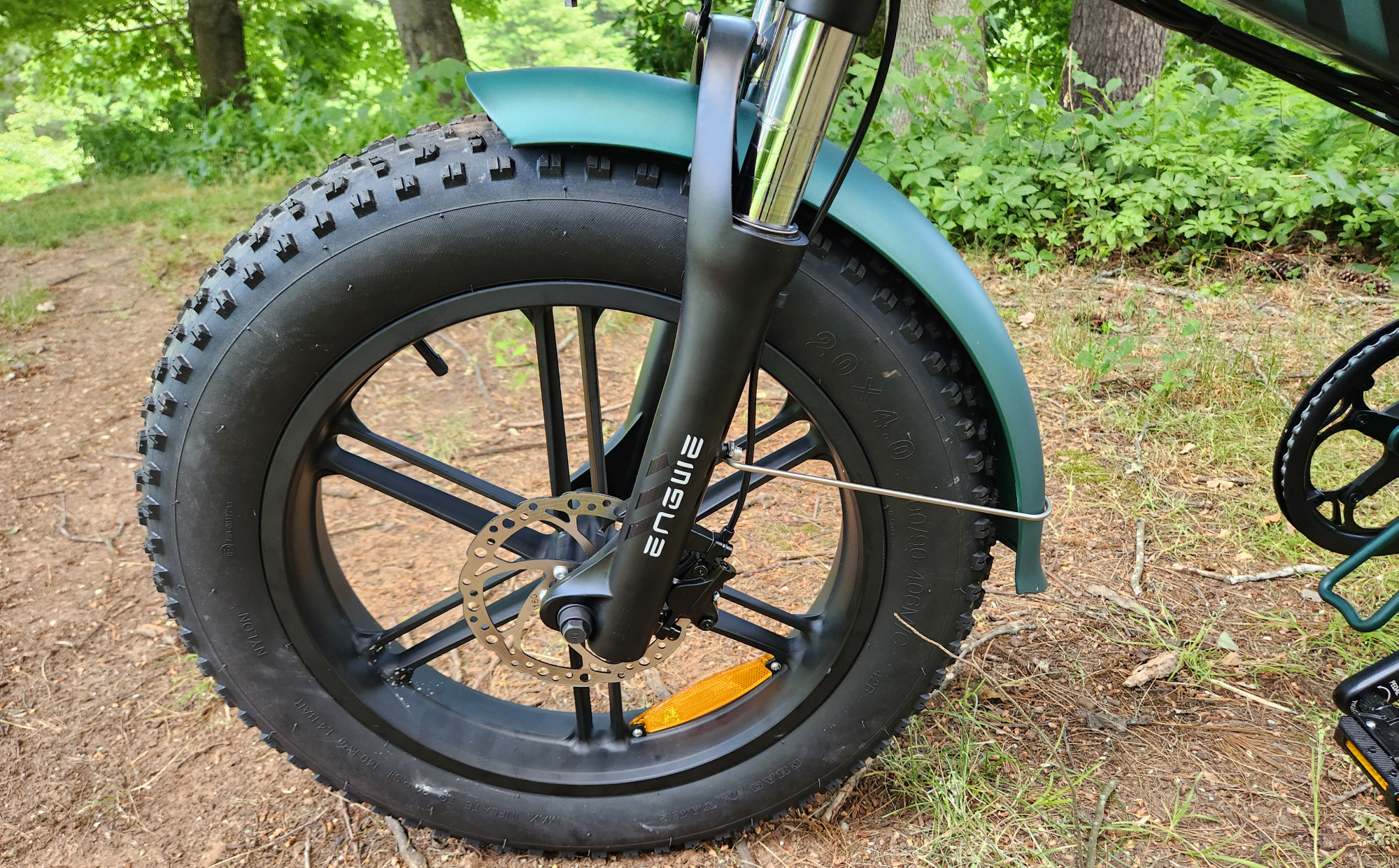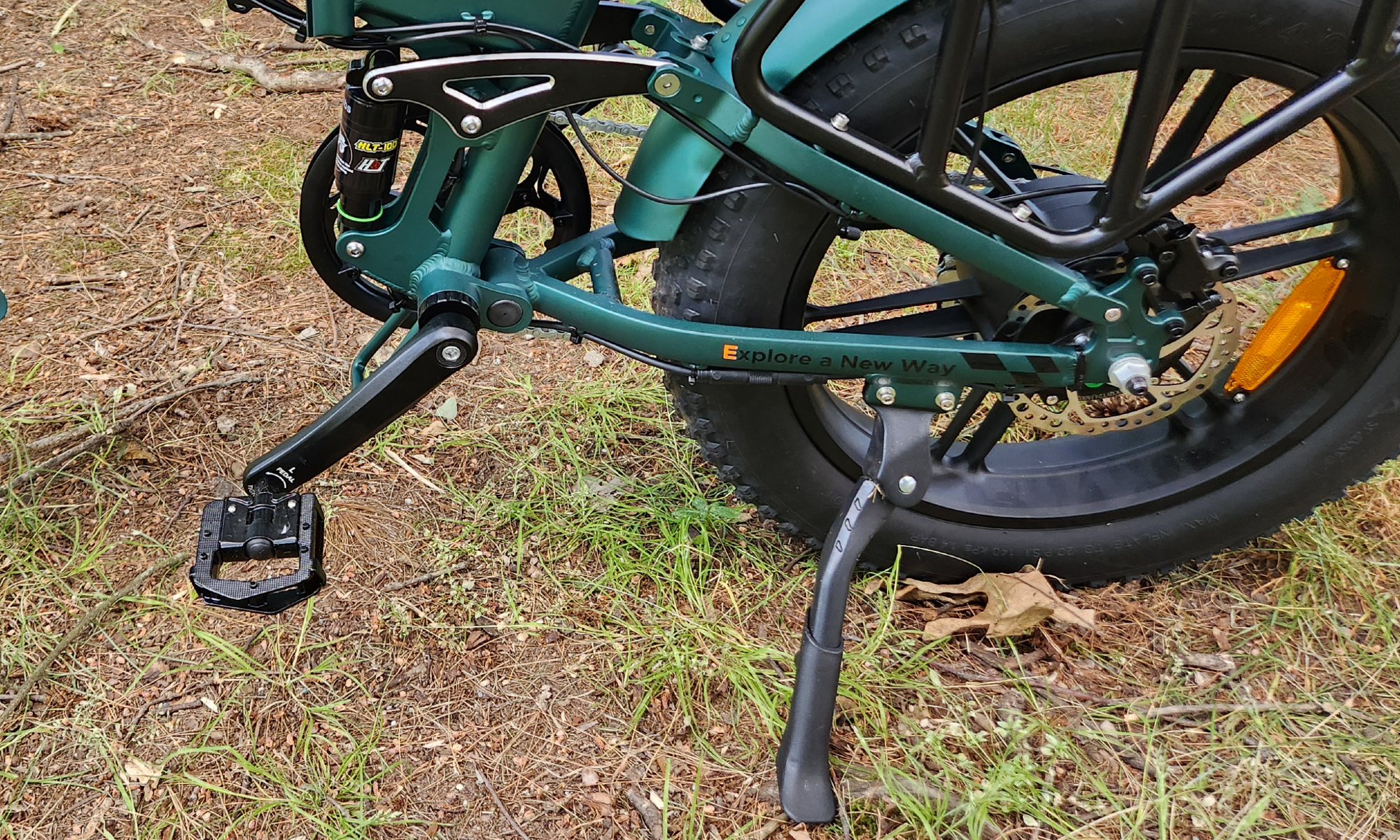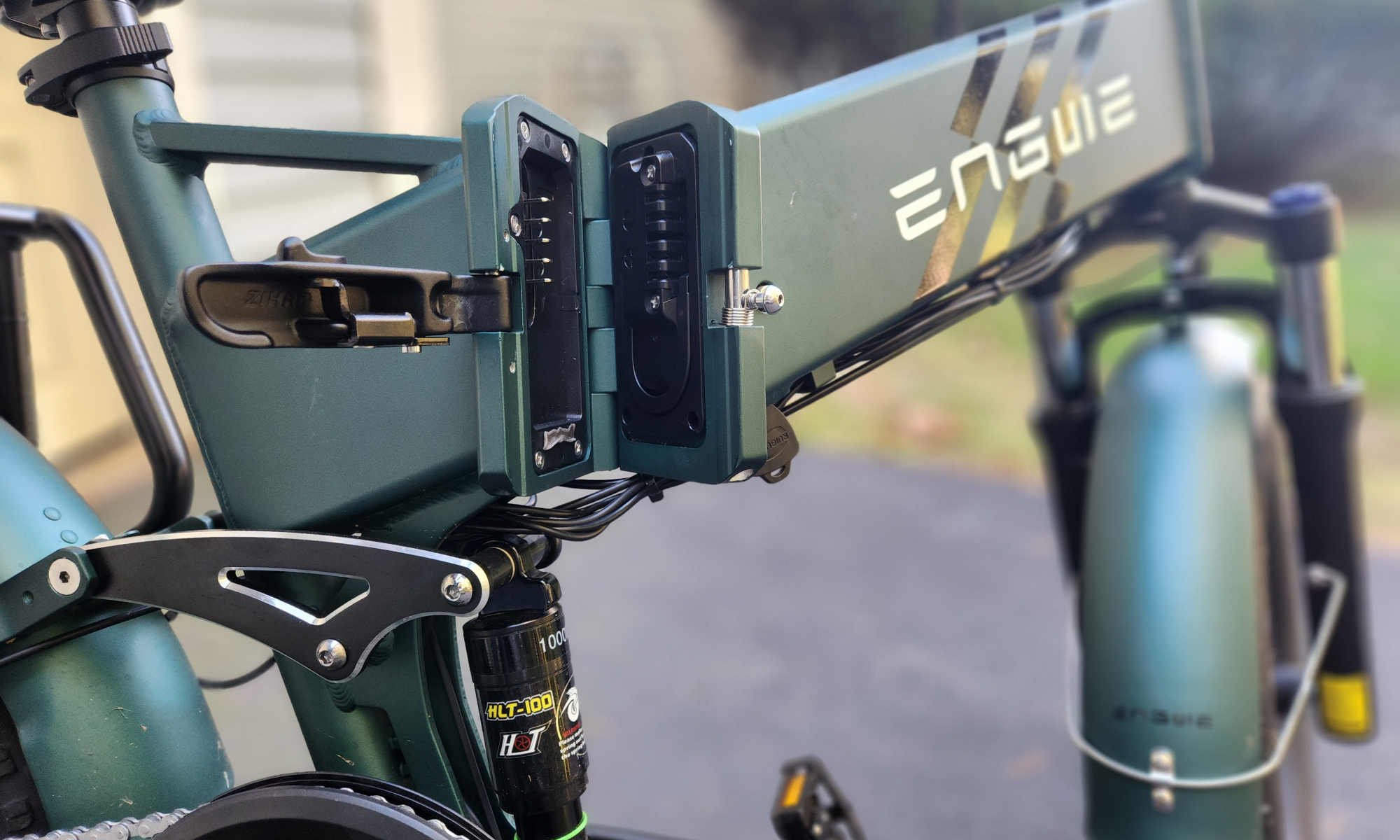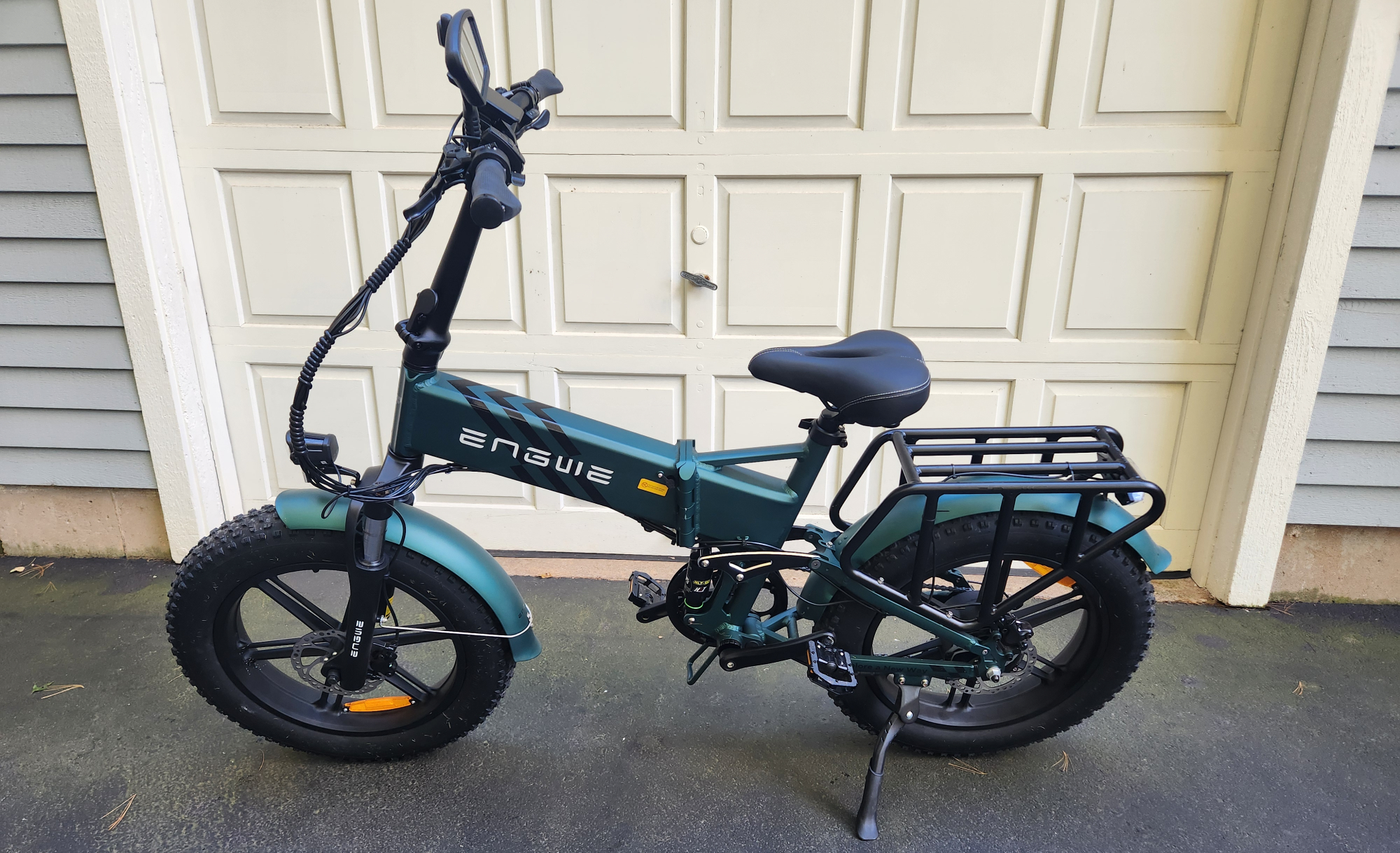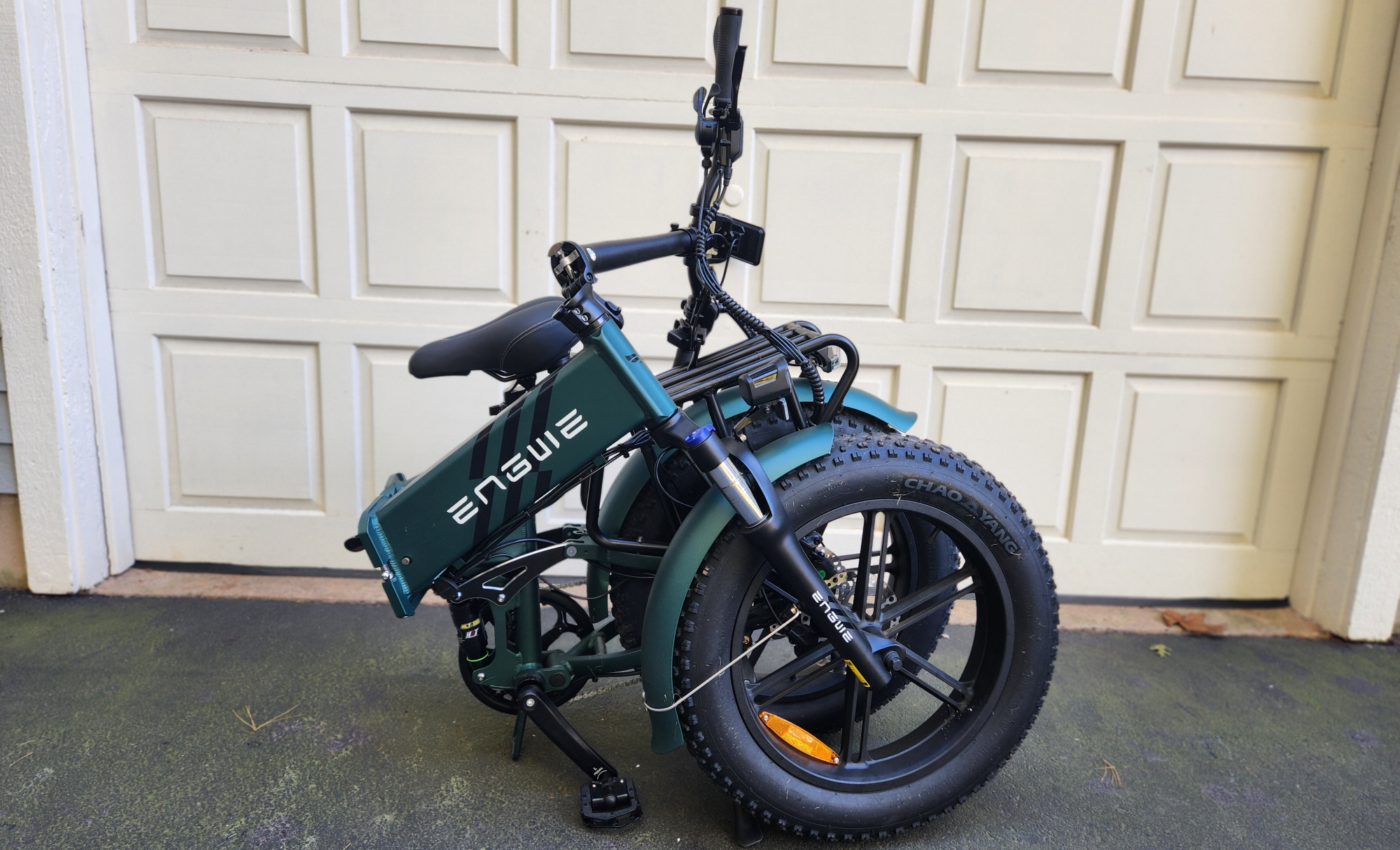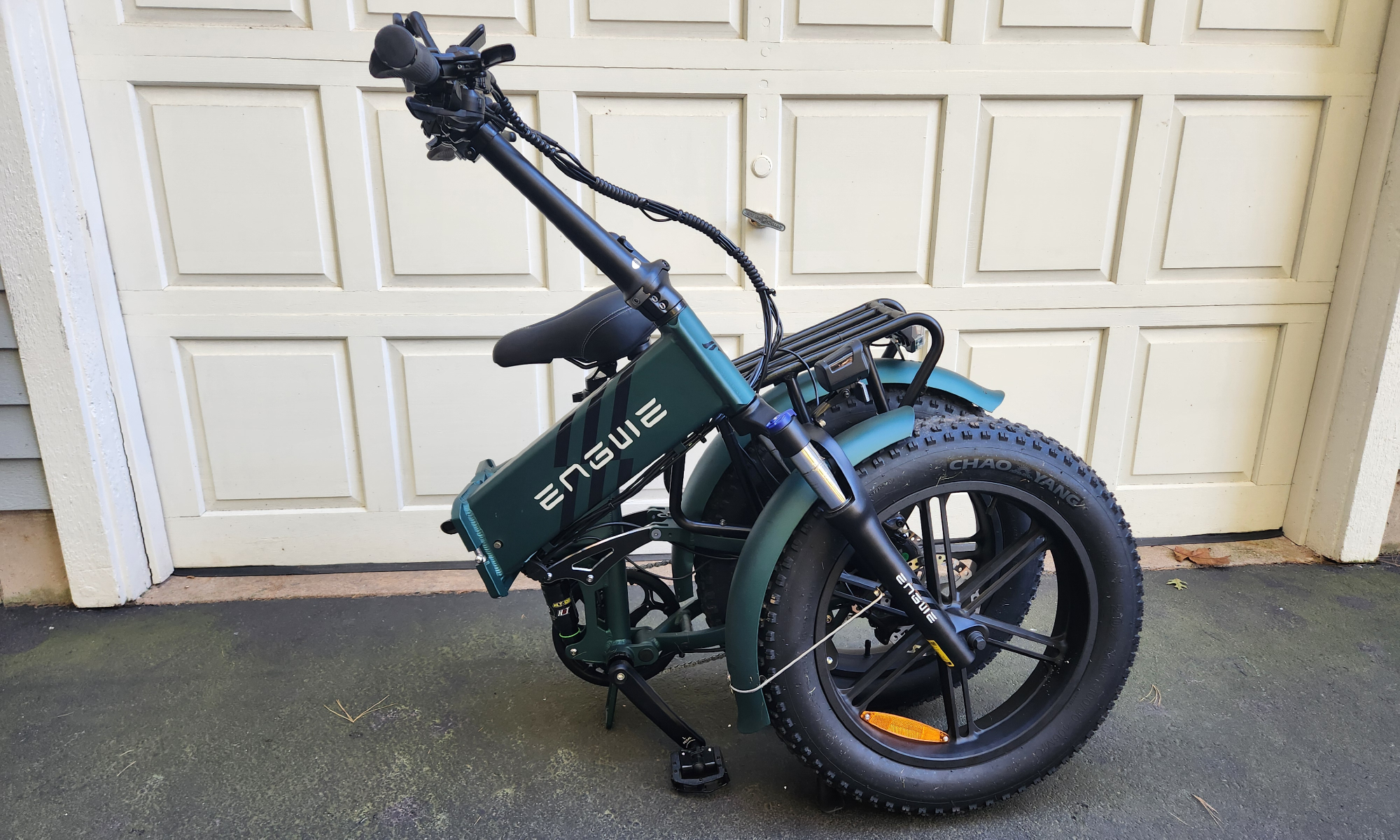“The Engine Pro 2 is a peppy, smooth-riding e-bike with safety and comfort upgrades from earlier models.”
- A lot of fun and utility for the money
- An all-purpose compact e-bike
- Significant upgrades from earlier versions
- Comfortable ride
- Good safety features
- Throttle speed limited to 20 mph
- Mirrors are not standard
- Minimum acceptable disc brake rotors
Testing the reminded me of the value you can get from folding e-bikes because they are easier to transport than any e-bike that doesn’t fold. You don’t need a heavy-duty hitch rack, a truck, a trailer, or SUV. You can put the Engwe Engine Pro 2 in the trunk or even the back seat of most cars. The only cars I’ve driven that wouldn’t accommodate the Engwe Engine Pro 2 were an MGB and a Miata.
In June 2023, I reviewed the Engwe EP2 Pro folding e-bike. It was a very good product and a great value at the time. The Engine Pro 2 has the same positive qualities as the EP2 Pro, along with many upgraded components.
Engwe Engine Pro 2 e-bike: purpose and best use

The Engwe Engine Pro 2 is an all-purpose e-bike that’s easy to transport. It’s a fine urban transportation alternative or commuter bike, as long as you don’t need to carry its 88-pound weight up or down stairs.
Engwe describes the Engine Pro 2 as an outdoor adventure or even a mountain bike, but it’s not designed for competitive trail riding or tough mountain trails. Its semi-knobby fat tires can handle dirt roads and moderately rough terrain.
Engwe Engine Pro 2 e-bike: by the numbers

The Engwe’s upgraded components start with the 750-watt continuous power rear hub electric motor that peaks at 1,200 watts, up from 1,000 watts in the previous version. Maximum torque has increased from 55 to 75 Newton meters, which helps with fast starts and on inclines.
Engwe improved the pedaling gear set from seven to eight speeds. More important is the change from a speed-based cadence sensor to a torque sensor that feels more natural when it adds power assistance based on the pedaling force.
I usually stand on the pedals to avoid discomfort from rough spots or bumps, but I rarely needed to stand with the Engine Pro 2.
The battery has also been upgraded from a 48-volt system to a 52-volt system, and the amperage has been bumped from 13 amps to 16 amps. The battery capacity has increased from 624 watts to 832W, a one-third boost. Engwe rates the maximum range at 30 miles with throttle only or 68 miles using pedal assistance. Charging with the upgraded 3-amp charger takes 6.5 hours.
You can use the bike’s thumb throttle alone to reach speeds up to 20 mph, but to go faster, to a maximum of 28 mph, you have to use pedal assistance power. The earlier Engwe model allowed throttle-only speeds to 28 mph, so that’s a disappointment, even if it does conform with the e-bike class regulations adopted by most states.
Engwe Engine Pro 2
| Electric motor power (continuous/maximum) | 750 watts/1200 watts |
| Maximum torque | 75 Newton meters |
| Top speed (pedal assist/throttle) | 28 mph/20 mph |
| Battery power (volts x amps = watts) | 52v * 16a = 832 watts |
| Battery range (pedal assist/throttle) | 68 miles/30 miles |
| Battery charge time with 3a charger | 6.5 hours |
Engwe Engine Pro 2 e-bike: comfort and convenience
Rider comfort is improved with the Engine Pro 2, which matters, even though the previous version did a good job of smoothing rides on rough surfaces. The most significant change is the suspension. The tested e-bike has an adjustable front hydraulic fork and a four-link rear suspension, while the older version has a spring-loaded front fork and no rear suspension.
Unlike the earlier model, the new seat is thicker and includes springs, which adds to the overall riding comfort. It’s also a fat tire bike with 20-inch wheels and 4-inch wide tires, which can soften the ride if you deflate the tires a bit from the maximum level. The recommended maximum is 20 psi, but I found 15 psi to be a good compromise.
The newer model’s ride is smoother, especially over speed bumps or uneven surfaces. When riding bikes with minimal or no suspension, I usually stand on the pedals to avoid discomfort from rough sports or bumps, but I rarely needed to stand with the Engine Pro 2.
Engwe designed the Engine Pro 2 for riders between 5 feet, 4 inches and 6 feet, 2 inches tall. Its total weight capacity is 330 pounds, which includes the rider, clothing, gear, and anything attached to the rear rack, which has a 120-pound maximum.
Engwe Engine Pro 2 e-bike: safety and security

The Engine Pro 2 has been upgraded to hydraulic disc brakes from mechanical disc brakes in the earlier versions. The 160mm disc rotors are disappointing because most competitive brands now use 180mm rotors for greater braking surface. Since this bike can reach 28 mph with more than 300 pounds on board, more stopping power would be a wise improvement.
The Engwe has a headlight and a combination of taillight and brake light. It doesn’t have turn signals or a bell, but the lack of either isn’t a big deal.
The motor’s torque was more than enough to climb my long, steep driveway from a standing start using the throttle alone.
The bike does not come with mirrors, which is a serious omission with street bikes, although admittedly, very few e-bikes do. Engwe sells accessory mirrors, and I highly recommend buying them.
The only standard security measure with the Engine Pro 2 is the key for operating the bike. The keyhole is under the frame crossbar, which is awkward to use. You’ll also need the key to fold the bike or to remove the battery to charge it off of the bike (you can also charge it in place) and reduce the weight while carrying the bike. Buying a bike lock (or more than one) is a good move to protect the bike.
Engwe Engine Pro 2 e-bike: special features
The Engwe’s folding mechanism makes it much easier to store and transport than a fixed frame e-bike. The folding process involves several steps you’ll likely need to practice a few times. The frame, handlebar stem, and pedals all fold to a fairly compact 41 inches by 21.5 inches by 33 inches, which is compact enough to fit in the trunk of most cars. Keep in mind that it weighs 88 pounds with the battery installed. If you remove the battery, the weight drops to 70 pounds, which is still a bit much for many people to lift very high or carry up a flight of stairs.
Engwe Engine Pro 2 e-bike: riding impressions

I enjoyed riding the Engwe Engine Pro 2. While I wish I could reach the 28 mph maximum speed with just the throttle, the throttle cutout at 20 mph is only a moderate nuisance. In testing, I reached 27.5 mph using pedal assistance to see if I could, but otherwise, I used the throttle only most of the time. The motor’s torque was more than enough to climb my long, steep driveway from a standing start using the throttle alone.
Even though I’m not big on pedaling, I did test pedaling with no power and, like its predecessor, the Engine Pro 2 is pretty easy to pedal, at least on even ground. The brakes were great. I’d like 180mm disc rotors, but the standard brakes performed well, including repeated emergency stops with no issues.
The ride was comfortable. It’s not as smooth as some of the heavier, motorcycle-style e-bikes I’ve tried, such as the Ride1Up Revv1, but the Engwe’s convenience size made it the bike I reached for most often when I needed to ride to our shared mailbox or run quick errands. It’s a very good e-bike to grab and go, and it’s perfect for everyday riding.
Engwe Engine Pro 2 e-bike: options and accessories

Our take
I definitely recommend the Engwe Engine Pro 2 folding e-bike. It’s a very good value at $1,399, and is usually discounted. The Engine Pro 2 is a peppy, smooth-riding e-bike with significant safety and comfort upgrades from earlier models. It’s available in black or blue, but I think the green finish looks the best.
Two similar folding e-bikes are the Lectric XP 3.0 Long-Range and the HeyBike Mars 2.0. The Lectric XP 3.0 Long Range lists for $1,299 and has 180mm rotors for its hydraulic disc brakes. The Lectric motor peaks at 1,000 watts, less than the Engwe, but Lectric’s PWR power algorithms balance power and range nicely. The XP 3.0 lacks a rear suspension, one of the Engwe’s strong points.
The HeyBike Mars 2.0 folding bike lists for $1,799, though it’s usually discounted by several hundred dollars. The Mars 2.0 also has hydraulic disc brakes with 180mm rotors, and its more powerful motor peaks at 1,800 watts, helping the bike reach speeds up to 32 mph, which I’ve experienced firsthand. The Mars 2.0 is a fast, solid option, but, like the Lectric, it lacks a rear suspension.
While all three bikes are great options, the Engwe’s four-link rear suspension provides a more comfortable ride on bumpy roads. If comfort is a priority, the Engine Pro 2 is the best choice.


